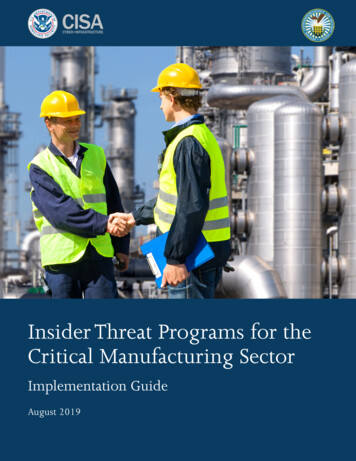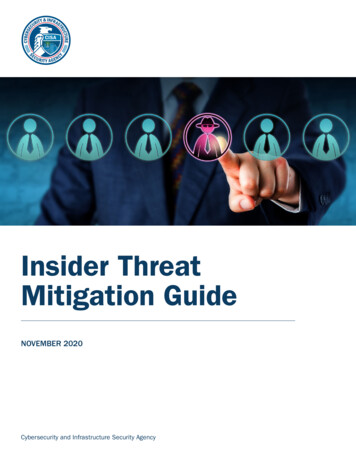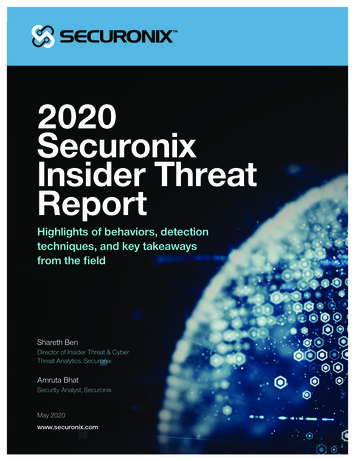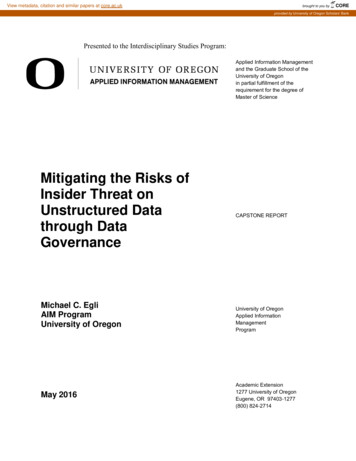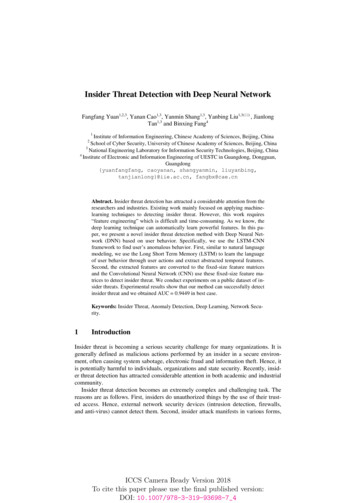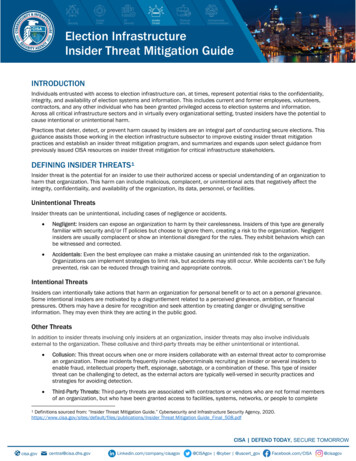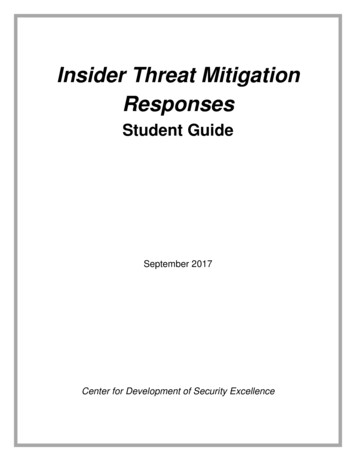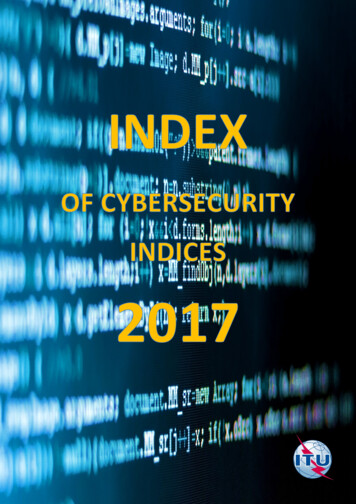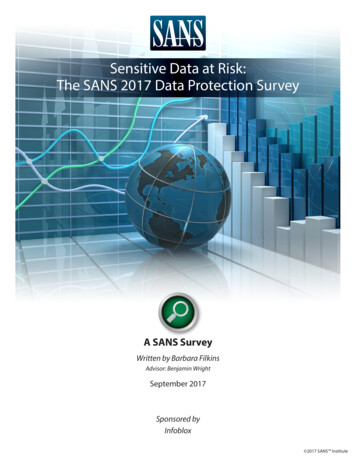
Transcription
Insider ThreatPotential Risk Indicators (PRI)JOB AIDCenter for Developmentof Security ExcellenceNOVEMBER 2021
CONTENTSClick the individual links to view eachtopic. You may also use the forward andbackward arrows to navigate through eachtopic in order.3 Introduction4 Access Attributes5 Professional Lifecycle and Performance6 Security and Compliance Incidents7 Technical Activity8 Allegiance to the United States9 Foreign Influence and Preference10 Outside Activities11 Financial Considerations12 Substance Misuse and Alcohol Consumption13 Personal Conduct14 Criminal Conductwww.cdse.eduPOTENTIAL RISK INDICATORS JOB AIDHOMEPREVIOUSNEXT2
INTRODUCTIONWhat is an insider threat?While specific definitions vary across Government, law enforcement, and industry, an insider threat is generallyconsidered the potential for an individual to use authorized access to an organization’s assets to wittingly orunwittingly do harm. The damage from insider threats can manifest as espionage, theft, sabotage, workplace violence,or other harm to people and organization. Possible insiders include employees, contractors, vendors, suppliers, andpartners—anyone to whom an organization has granted special trust and access.What are potential risk indicators (PRI)?Individuals at risk of becoming insider threats, and those who ultimately cause significant harm, often exhibit warningsigns, or indicators. PRI include a wide range of individual predispositions, stressors, choices, actions, and behaviors.Some indicators suggest increased vulnerability to insider threat; others may be signs of an imminent and seriousthreat.Why are spotting and reporting PRI so important?Indicators do not always have diagnostic value or reflect wrongdoing.Some PRI may involve activities that are constitutionally protected. Timelyand appropriate reporting of PRI is crucial for assessing and mitigatinginsider threats. National security, critical services, and public safety dependon it. Preventing harm due to insider threat is a shared responsibility.Individuals adhere to insider threat policies and procedures; organizationsinvestigate potential threats while preserving employee privacy and civilliberties.For whom was this job aid created?This job aid is for individuals who require national security eligibility forsensitive positions or access to classified information. Compared to thegeneral public, such individuals are subject to unique standards ofconduct and mandatory reporting of certain risk indicators. Specialemphasis is given to PRI commonly associated with nationalsecurity and the protection of classified information.How should this job aid be used?This job aid is not all-inclusive. Use it as a tool to developadditional PRI based on an organization’s distinct mission andpriorities. Utilize it also as a reminder of the exceptional duty ofcare vested in those with national security responsibilities.Readers should further consult applicable and controlling laws,regulations, policies, and procedures. Visit CDSE’s Insider ThreatToolkit for additional training and resources hreat-Toolkit/.www.cdse.eduPOTENTIAL RISK INDICATORS JOB AIDHOMEPREVIOUSNEXT3
ACCESSATTRIBUTESAccess is at the heart of understanding and characterizing insider threats.Without access, there is no “insider.”Organizations grant individuals differentkinds of access, like physical entry to buildings or virtual access to computer networks.Access may also result from specialized training,acquired skills, and organizational knowledge.Some insider threat risk is systematic or inherent:organizations cannot function without entrustingpeople with valuable tools and information. However,risk is lessened when sensitive access is properly assigned,managed, and protected.Examples Security clearances Confidential Secret Top Secret (TS) Additional information controls Sensitive Compartmented Information (SCI) Special Access Programs (SAP) Controlled Unclassified Information (CUI) Physical security access Non-public government facilities Sensitive compartmented information facilities (SCIF) Private sector critical infrastructure Systems and applications Information network domains (SIPR, JWICS, etc.) Databases and systems of record Privileged accounts and credentials Remote access Training, tradecraft, and material Military equipment, weapons, and tactics Chemical, Biological, Radiological, Nuclear, andExplosives (CBRNE) Protected technologyLEARN MORE: An individual’s office, position, or security eligibility alone, does not determine access to protectedinformation. It must be necessary for the performance of one’s official duties. For a short refresher on the “Need-toKnow” principle, watch the CDSE video lesson at uPOTENTIAL RISK INDICATORS JOB AIDHOMEPREVIOUSNEXT4
PROFESSIONAL LIFECYCLE AND PERFORMANCEAll individuals possess a unique set of characteristics and circumstances that influence their risk of becoming aninsider threat. Organizational change, career progression, job performance, and other workplace dynamics can berelevant factors. Human resources personnel and supervisors are often positioned to recognize risk indicators relatedto professional lifecycle and performance. Some indicators may seem routine or commonplace—not everyonegets the promotion; some employees underperform, quit, or are fired—but when there is grievance, conflict, orunanticipated duress, such indicators deserve security concern.Examples Furloughs and lay-offsSeparations and terminationsDemotions and reprimandsNon-judicial punishmentsLeaves of absenceUnauthorized absence / AWOLInvoluntary administrative leaveHardship leaveDeclining performance ratingsPoor performance ratingsHuman resources complaintsNegative characterizations of previous employment or serviceLEARN MORE: Human Resources departments play an important role in deterring,detecting, and mitigating insider threat risk. Responsibilities begin prior to,and continue beyond, an individual’s employment with an organization.See the training short, Human Resources and Insider Threatat timedia/shorts/hrinsider/story html5.html.www.cdse.eduPOTENTIAL RISK INDICATORS JOB AIDHOMEPREVIOUSNEXT5
SECURITY AND COMPLIANCE INCIDENTSThe proper handling and safeguarding of protected information is crucial to combating many insiderthreats such as fraud, theft, and espionage. Protected information includes proprietary information,in addition to classified and other sensitive Government information. All individuals with accesshave a duty to adhere to rules and regulations for protected information. Compliance failures area security concern whether they are deliberate or not—insider threats are frequently the resultof negligence. Risk indicators include security and compliance violations, unauthorized useor disclosure, and any inappropriate efforts to view or obtain protected information outsideone’s need to know.Examples Violations related to the handling of protected information Disclosure to unauthorized persons (e.g. personal or business contacts,media) Unauthorized collection, retention, or storage Using unauthorized equipment or mediums for protected information Attempts to obtain information without proper clearance orneed-to-know Unauthorized modification of information to conceal or removeclassification, or control markings Negligent or lax physical or information security practices despitecounseling Non-compliance with security training requirements Security clearance denial, suspension, or revocation Failure to self-report information required for securityclearance eligibility Misuse of information security privileges or credentials Misuse of facilities or work-issued equipment Anomalous or suspicious accessing of facilities orsystems during non-work hoursLEARN MORE: Security procedures for storingsensitive material include proper facilities,containers, and labels. In some instances,guards and alarm systems are mandatory.Requirements for protection increasewith sensitivity. Take the training short,Classified Storage Requirements at ENTIAL RISK INDICATORS JOB AIDHOMEPREVIOUSNEXT6
TECHNICAL ACTIVITYAs organizations adopt information technology to improve operations, they also require additionalsafeguards to prevent insider threats. Information technology comprises an organization’s systems,networks, devices, and associated components such as hardware, software, or firmware. Indicatorsof the misuse of information technology may also involve the mishandling of protectedinformation. This section highlights inappropriate or unauthorized use of any informationtechnology that could lead to, or be evidence of, insider threat. User Activity Monitoring(UAM), a requirement for many organizations, provides a continuous and enhanced meansof detecting and recording technical activity.Examples Unauthorized access or use of any information technologyViolations of acceptable use or other automated information system policiesSuspicious or improper activity or correspondence on any systemUnauthorized modification, destruction, or manipulation of anyinformation technologyUnauthorized deletion or modification of electronic records or dataDownloading, storing, or transmitting protected information usingunauthorized information technologyUnauthorized introduction, removal, duplication, or disabling ofsoftware on any systemNegligent or lax information technology security practicesdespite counselingLEARN MORE: User Activity Monitoring (UAM) softwareprotects organizations against potential insider threats bymonitoring, logging, and recording individual user activitiessuch as keystrokes, email, chat, and web browsing. See theCommittee on National Security Systems Directive 504definition of UAM at 81022-UAM-Definition.pdf.www.cdse.eduPOTENTIAL RISK INDICATORS JOB AIDHOMEPREVIOUSNEXT7
ALLEGIANCETO THEUNITED STATESIndividuals in the military, Government,or other positions of public trust, are heldto a higher standard of conduct compared tothe general public. Such individuals may haveaccess to Government facilities, weapons, tactics,training and intelligence—all of which requiresafeguarding. While there is no positive test for it,allegiance may dictate an individual’s willingness toprotect classified or sensitive information. Negativeindicators are broad and include participation in, orsupport for, acts against U.S. interests; placing the welfareor interests of another country above those of the U.S.; andactive participation in extremist organizations that advance,encourage, or advocate the use of violence.Examples Support or advocacy of any acts of sabotage, espionage, treason,terrorism, or sedition against the U.S. Association or sympathy with persons attempting or committing such acts Association or sympathy with persons or organizations who advocate,threaten, or use violence in an effort to Overthrow or influence federal, state, or local Government Prevent Government personnel from performing their official duties Gain retribution for perceived wrongs caused by the Government Prevent others from exercising their constitutional or legal rights Active participation in violent extremist groups may include Fundraising, demonstrating, and rallying Recruiting, training, and organizing Distributing print or online material Knowingly wearing clothing, or having tattoos associated with such groupsLEARN MORE: For an expansive list of indicators of domestic violent extremism, see HomegrownViolent Extremist Mobilization Indicators, 2019 Edition, jointly produced by the NationalCounterterrorism Center, FBI, and DHS at ilization-indicators-2019.www.cdse.eduPOTENTIAL RISK INDICATORS JOB AIDHOMEPREVIOUSNEXT8
FOREIGN INFLUENCE AND PREFERENCEForeign associations may exist for a variety of reasons, including familial ties or work duties. Foreigncontacts and interests rise to a national security concern when they result in divided or conditionalU.S. allegiance. They also pose risk if they create vulnerability to foreign manipulation, coercion,or pressure to act against U.S. interests. Contacts from countries linked to terrorism or knownto target U.S. citizens for intelligence operations may be of particular concern. Foreigninvolvement, such as possessing or seeking foreign citizenship, while not inherently harmful,is a security concern when an individual expresses foreign preference over U.S. interests orattempts to conceal such involvement.Examples Foreign travel to countries of concern Frequent unofficial foreign travel Foreign, unofficial contact with a known or suspected foreign intelligenceentity (FIE) Enabling or facilitating an officer, agent, or member of a FIE Continuing foreign national contact (to include personal contact,telephone, email, social media) bonds of affection intimate contact exchange of personal information Foreign business and political interests Foreign residency or property interests Foreign bank accounts and sources of income Possession of a foreign passport or identity card Voting in a foreign election Service in a foreign military or government Application for and receipt of foreign citizenship Foreign national cohabitant or roommateLEARN MORE: Individuals must report certainactivities, including foreign travel and contacts, forinitial and continued national security eligibility.For specific requirements, refer to the SecurityExecutive Agent Directive (SEAD)-3, ReportingRequirements; and SEAD-4, National SecurityAdjudicative Guidelines at POTENTIAL RISK INDICATORS JOB AIDHOMEPREVIOUSNEXT9
OUTSIDEACTIVITIESAn individual who engages inoutside employment or services,whether on a volunteer or paid basis,does not represent an inherent threat.However, outside activities are a securityconcern if they pose a conflict of interestwith an individual’s security responsibilities.Any involvement in outside activities thatincreases the risk of unauthorized disclosure ofprotected information is of particular concern.While potential risk indicators may have foreignconsiderations, they also include outside activitieswith U.S. organizations or persons, especially whenit involves matters of national security or sensitivetechnology. Failure to fully disclosure outside activitieswhen required is also cause for concern.Examples Foreign employment or service Government of a foreign country Any foreign national or organization Representative of any foreign interest Any employment or service involving analysis, discussion, orpublication of Intelligence National defense Foreign Affairs Protected Technology Concealment or failure to fully disclose outside activitiesLEARN MORE: Individuals are generally permitted to engage in outside activitiesthat pose no conflict with official duties, but should first consult with the appropriateethics office. The Department of Defense Standards of Conduct Office provides guidancefor active duty and civilian personnel at se.eduPOTENTIAL RISK INDICATORS JOB AIDHOMEPREVIOUSNEXT10
FINANCIALCONSIDERATIONSPersonal finances and finance-related activitiesmay have substantial bearing on an individual’ssuitability for holding sensitive positions andsafeguarding protected information. It is notuncommon for individuals to experience financialloss or hardship. However, financial distress is a securityconcern when indicates poor judgement or self-control;or it impairs an individual’s ability or willingness to adhereto rules and regulations. Financial distress may also arisebecause of, and thus indicate, other security concerns suchas gambling and substance addictions. Unexplained affluenceis pertinent to the extent it may result from criminal activity,including espionage.Examples Inability or unwillingness to satisfy debts History of unmet financial obligations Pay garnishment Loan defaults Liens or judgements Bankruptcy Evidence of frivolous or irresponsible spending Excessive debt Significant negative cash flow Late payments or non-payments Deceptive or illegal financial practices Embezzlement Employee theft Check or expense account fraud Mortgage or tax fraud Intentional financial misstatements Failure to file or pay income taxes Significant transactions, debts, losses or conflicts due to gambling Unexplained affluence Lifestyle or standard of living Increases in net worth or cash flowLEARN MORE: While the promise of financial gain may be the motivation for some insider threats, such as thoseinvolving espionage or theft, insiders are also driven by other factors like ideology or retribution for perceivedgrievances. The CDSE eLearning course, Insider Threat Awareness, offers historical examples and insight at w.cdse.eduPOTENTIAL RISK INDICATORS JOB AIDHOMEPREVIOUSNEXT11
SUBSTANCE MISUSE AND ALCOHOLCONSUMPTIONThe illegal use of controlled substances demonstrates an individual’s inability or unwillingnessto comply with laws, rules, and regulations. Substance misuse further raises concerns about anindividual’s reliability and trustworthiness because such behavior may also result in physical orpsychological impairment. Alcohol, while not illegal, can similarly increase the risk of insiderthreat when it is consumed inappropriately, excessively, or abusively. Alcohol-relatedincidents may be security concerns whether they occur at, or away from, the workplace.Examples Illegal drug use while granted access to classified information or holding asensitive position Illegal possession of a controlled substance, including drug paraphernalia Misuse of prescription and non-prescription drugs Drug test failures or refusals Qualified diagnosis of substance use disorder Alcohol-related incidents away from work (e.g. drinking and driving,disturbing the peace, spouse or child abuse) Alcohol-related incidents at work (e.g. reporting for dutyintoxicated, drinking on the job) Habitual or binge drinking to the point of impaired judgement Voluntary or involuntary treatment for drug or alcohol abuse Failure to follow court orders regarding drug or alcoholeducation, evaluation, treatment, or abstinenceLEARN MORE: Alcohol and substance use disorders,mental health, and financial issues are life challenges forwhich an organization’s Employee Assistance Program(EAP) may be of significant value. EAPs can mitigateinsider threat risk by providing timely and criticalsupport to individuals. The U.S. Office of PersonnelManagement provides more informationabout federal programs at AL RISK INDICATORS JOB AIDHOMEPREVIOUSNEXT12
PERSONALCONDUCTAccess to protected informationimparts responsibilities beyondcompliance with work rules andregulations. Some risk indicatorsinvolve behaviors or conditions that existoutside the workplace and do not rise tocriminal conduct. These may be significantbut under-reported, and revealed only after aninsider causes grave harm. Any personal conductthat undermines an individual’s trustworthinessand reliability; or, if known, could damage one’spersonal, professional, or community standing is apertinent security concern. National security eligibilityis normally not denied or revoked for certain personalconduct, but for falsifying or concealing relevant facts aboutthe conduct in question.Examples Disruptive, violent, bizarre, or other inappropriate behaviorFamily conflict and domestic abuseCompulsive, self-destructive, or high-risk behaviorsSexual behavior that causes vulnerability to coercion, exploitation, orduressEmotional or mental instabilitySelf-harm, harm to others, or suicidal ideationVoluntary or involuntary inpatient hospitalizationA pattern of dishonesty, falsifying information, or rule violationsAssociation with persons involved in criminal activityLEARN MORE: When it concerns national security, reportable actions by others arebroadly inclusive. Individuals should promptly report, but with discretion and only tothe appropriate officials. Once alerted, investigating officials are required to comply withprivacy laws and regulations. CDSE eLearning course, Insider Threat Privacy and Civil Liberties,examines the challenges of preserving both national security and individual rights at ources/.www.cdse.eduPOTENTIAL RISK INDICATORS JOB AIDHOMEPREVIOUSNEXT13
CRIMINALCONDUCTNot surprisingly, criminal conductraises doubts about an individual’sreliability and trustworthiness tohold sensitive positions and safeguardprotected information. On its face, itdemonstrates the inability or unwillingnessto comply with laws, rules, and regulations.Potential risk indicators of a criminal naturedo not require formal criminal charges orprosecution; credible allegations or admissions aresufficient. Minor offenses (certain traffic offenses,for example) are unlikely indicators of insider threat,unless they contribute to a pattern or combinationof offenses that causes concern about an individual’strustworthiness, reliability, or judgement.Examples Criminal violent behaviorSexual assault and domestic violenceWeapons-related crimesParole or probation or violation thereofFailure to follow court ordersCredible allegations or reports of criminal activityAdmissions of criminal activityA pattern or combination of minor criminal offensesMilitary discharge or dismissal for reasons less than “Honorable”LEARN MORE: Different responsible parties may best ascertain the risk of an insiderthreat at different times. Qualified investigators and adjudicators gather risk indicatorsand assess individuals for national security eligibility determinations. In other instances,insider threats are mitigated only when vigilant individuals observe and report potentialrisk indicators. For examples of recent insider threats, and the risk indicators associated witheach, explore the CDSE Case Study Library at e-studies/index.php.www.cdse.eduPOTENTIAL RISK INDICATORS JOB AIDHOMEPREVIOUSNEXT14
insider threats. National security, critical services, and public safety depend on it. Preventing harm due to insider threat is a shared responsibility. Individuals adhere to insider threat policies and procedures; organizations investigate potential threats while preserving employee privacy and civil liberties. For whom was this job aid created?

